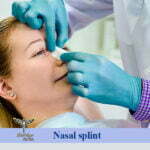A nasal splint is a plastic or silicone piece that is used to stabilize the nose after rhinoplasty. Some of them are chosen selectively after surgery. The procedures used to place the splint are relatively simple. Before leaving the treatment place, the best nose surgeon in Dubai will explain to you how to take care of the nasal splint and how long it will take to keep it in a fixed position.

What is a nasal splint used for?
There are two types of splints:
- Internally, which is inserted into the nostrils and fixed in place using a few stitches.
- A External nose splint is placed outside the nose and is fixed in place with medical adhesives or bandages, or adhesives are used to connect it to the skin of the desired area, which dissolves spontaneously within a few days.
Splints serve two important purposes:
- They stabilize the tissue on which the surgery was performed.
- They protect the nose during the healing process.
Nasal splints are used after various types of nose surgery:
- rhinoplasty
- Septoplasty
- Repair of a broken nose
- Medical Reasons for a Nose Job
The choice of internal or external splint is determined based on the type of operation performed. Here we mention some approaches to nose surgery that require the use of internal or external nasal splints after their implementation.
rhinoplasty
Rhinoplasty is a procedure that is performed to change the appearance of the nose and help improve breathing. This is one of the most common forms of plastic surgery. After nose job, a splint is placed outside the nose to fix the nasal tissue that has been treated.
Septoplasty
If the septum—the bony and cartilage wall that divides the nose into two openings—is broken or deviated and makes breathing difficult, you may be a good candidate for septoplasty. Septoplasty is a surgical procedure that straightens the deviated septum to improve breathing. After septoplasty, the nasal cavity is filled with sterile gas and internal splints are used in each nostril to stabilize the treated septum and compress the septum to help reduce bleeding complications.
Broken nose surgery
The upper part of the nose is made of bone, and the rest of it is made of cartilage. A nasal fracture is a cracked part that occurs in the bone or cartilage of the nose. Sometimes, a broken nose can be repaired manually. But in serious cases, the surgery is used to repair and restore the nose and return it to its original shape and size.
Medical reasons for a nose job
Sometimes nose surgery is needed to remove congestion caused by reasons other than septal deviation. For example, the removal of nasal polyps from nasal cavities can be done using rhinoplasty techniques with surgical methods. Nasal splints are often used following other types of nose surgery.
How does a nasal splint work?
The reason for using a splint is that the size and shape of the nose, nostrils, or septum are different after nose job. The splint helps maintain the new shape and size of the nose until it heals. It also protects the nose if it is accidentally hit in the days after the surgery.
Internal splints are slightly curved tubes that first keep the nostrils open and then slightly penetrate the nasal cavity. An external nasal splint is trapezoidal. The narrower part is placed on the upper bridge of the nose and the wider head can cover the lower part of the nose.
Splint placement process
Here are the procedures used for internal and external splint placement:
External splint
Rhinoplasty is one of the most common procedures that require the use of an external nasal splint. After surgery, the nose is bandaged and a flexible external splint is placed over the bandage to cover and protect the nose, which is removed after the bandage is removed.
Internal splint
After nose surgery, the best nose surgeon will place internal nasal splints in each nostril and temporarily connect them to the inner wall of the nostrils with one or two stitches. After a few days or a week, you visit the office of the best nose surgeon in Tehran to have the stitches and splint removed.
What to expect after the nasal splint is removed?
An external splint is usually left in place for a week or two after nose job. Of course, the length of time it stays on the nose varies from 3, 5, or 7 days, depending on the comfort level of the person. Here are some tips about the dos and don’ts of using a nasal splint after surgery:
- You should change the dressing over the splint. Be sure to get instructions from the best rhinoplasty surgeon in Dubai before leaving the treatment facility.
- Avoid touching the external splint and the operation site during the first few days after the rhinoplasty procedure.
- If your external splint is loose or falling off within 48 hours of surgery, visit your doctor’s office for instructions.
- If you have a fever or heavy bleeding, immediately see a nose surgeon at the best plastic surgery clinic in Dubai.
- Use saline sprays to help reduce mucus build-up around the splint. The internal splint has hollow tubes to facilitate breathing, but the formation of mucus can make breathing difficult.
- The external splint sometimes makes you sloppy, but this is temporary and will be removed when the nose finds its desired shape.
When should you see a doctor?
Nose injuries in sports competitions , or other causes, if severe, can cause bone or cartilage fractures. If you feel you have a broken nose, see a doctor. Some of the more common symptoms of a broken nose include:
- Pain in or around the nose
- crooked nose
- Swelling of the nose
- nose bleeding
- Bruising around the eyes
You can also benefit from using a nasal splint if breathing is difficult after the surgery. The best plastic surgeon in Dubai will examine and test your nasal cavity to determine nasal deviation or other obstructions that can be treated with rhinoplasty.
What to do if the nasal splint loosens?
In rare cases, the splint loosens during the recovery period. In such a situation, you should contact a doctor. Usually, the doctor advises you to take a shower on the seventh day after the surgery when the nasal splint is to be removed and let the water flow over your nose completely and loosen the splint. This helps to remove the nasal splint from the nose more easily.
Does it hurt to remove the nasal splint?
Many patients experience a mixture of fear and excitement when attending the doctor’s office to have the splint removed. The doctor slowly removes the external and internal splints to reduce the pain experience. Patients often report experiencing slight pressure when the splint is removed. Of course, some of them experience a little pain. When the splint is removed, the patient can see his new post-surgery face for the first time.
Is it possible to breathe through the nose with a splint?
An internal nasal splint is a temporary tool used to care for the nose during the recovery period after surgery. During this period, normal breathing is disturbed due to the presence of the splint. After the splint is removed, breathing returns to normal.
Does the splint have side effects?
Nasal splints are usually not dangerous. Some of its possible complications include the following:
- The splint may cause discomfort in the nose and its removal may experience some pain. The nasal splint gets stained with blood and it becomes a little difficult to separate it when the splint is removed.
- Sometimes the splint becomes loose and causes problems



